These low-income families want to eat fresh, healthy food but it's becoming costlier and charities are strapped for donations
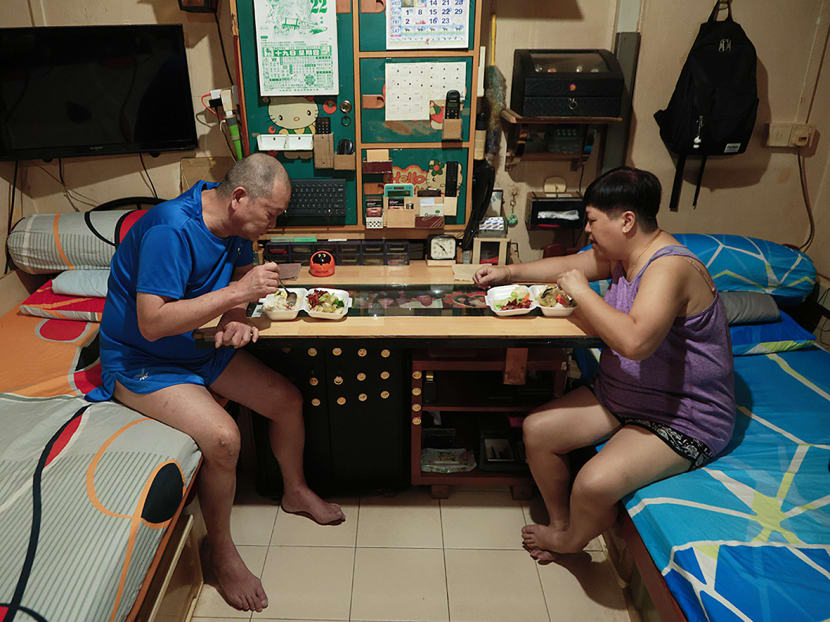
Mr Ng Koon Guan, 60, and his wife Alice Foong, 54, having dinner in their rental flat on Aug 22, 2024.
Listen to this article
13 min
This audio is generated by an AI tool.
- The rising cost of food is making it tough for residents living in public rental flats as they stretch their meal budgets
- They know that the low-income communities in their midst need nutritious and healthy meals but cannot always have these
- These families typically rely on instant noodles or more affordable options with minimal protein and fresh vegetables
- Non-governmental organisations that provide food donations to these communities are also limited by declining resources
- Experts and the authorities said a "multi pronged aproach" spanning education and assistance is needed to build healthier eating habits

By Nikki Yeo
Published August 24, 2024
Updated August 24, 2024
SINGAPORE — When single mother Nor Jalila worked full-time as a customer service officer at the Woodlands Checkpoint, her five children aged 12 to 21 regularly ate fast food out of convenience.
Now, plenty of vegetables and avoiding processed food is “a must” in their diet as prescribed by her family’s doctors, because she and her children have a host of health problems.
Ms Jalila is a cancer patient, while one of her sons has cancer in the lymph nodes and the other son has a brain tumour.
Deemed medically unfit to work, the 44-year-old homemaker, who lives in a two-room rental flat in Woodlands, takes great care to ensure that they have healthy, home-cooked food.
"All my five kids are not well, and the doctor advised us not to eat fast food, food bought from outside, which is not healthy. So what I'm trying to do since then is prepare home-cooked fresh fish, fresh chicken," she said.
Read also
Number of HDB coffee shops selling budget meals to jump 5-fold; heartland shops to pay less to upgrade store fronts
However, the rising cost of fresh ingredients has made it increasingly difficult to maintain this diet.
“When they were babies, we needed only diapers and milk. But now, boys, they eat quite a lot and I have to spend more, so groceries cost me at least S$500 to S$600 a month,” Ms Jalila said.
To manage, she has been getting food rations from charities, which provide staples such as rice and cooking oil, and she has received financial aid and grocery vouchers from various organisations.
With multiple medical conditions of his own, Mr Ng Koon Guan, 60, who is unable to work, and his wife, 54-year-old cleaner Alice Foong, get by on her salary of around S$900 a month.
Most of Madam Foong's income goes towards food and they spend around S$30 a day over their three meals.
With other expenses such as utilities and phone bills being less flexible, their food budget is where they cut costs, by buying the cheapest options at the economical rice stall, eating leftovers from friends and stretching food rations that they receive from charities.
Read also
Community Heroes: I keep a fridge and freezer outside my flat well-stocked, so that my neighbours do not need to go hungry
“The rations do help with a couple of meals, but the things they give, you can’t eat every day. You only have one can of sardines — one meal and it’s already gone,” Mr Ng said.
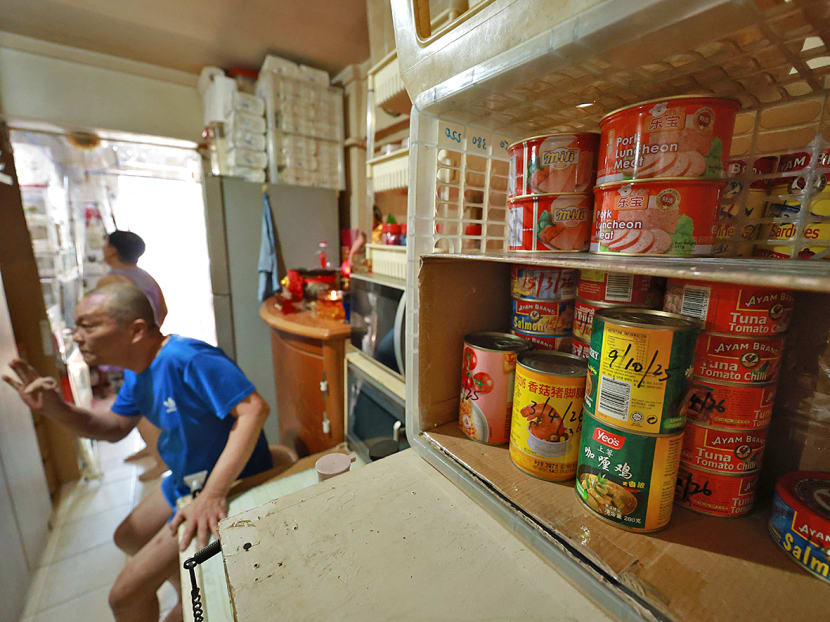
In TODAY’s conversations with residents living in public rental flats, many of them echoed these sentiments: Despite being well aware of the importance of a nutritious diet, they said that they simply cannot afford it in the midst of rising costs of living.
At the same time, the charities providing food supplies to these low-income families are also seeing their resources stretched as a result of lower donations and higher costs.
As part of a push to encourage people to eat healthier, the health authorities unveiled on Thursday (Aug 22) a move to introduce nutrition labels for instant noodles, salt, cooking oil and sauces in order to reduce the high intake of sodium and saturated fat by the population here.
The National Population Health Survey 2023, which also surveyed self-reported chronic diseases in the population, found that people with post-secondary education had a "much lower" incidence of self-reported high blood pressure than those with primary and secondary level education.
Similarly, a larger percentage of residents with primary level education reported having high blood cholesterol and diabetes than those with secondary or post-secondary education.
Read also
10% of Singaporean households don’t eat enough to stay healthy, some have just a meal daily: Study
The national survey uses highest education level attained as a proxy for "socio-economic factors".
HIGH BAR TO HEALTH
Ms Nurul Jannah Jumari, 25, who lives in a two-room rental flat with her husband, tries to prepare healthier meals for their five children aged one to seven.Her children have a genetic blood disorder, which affects their immune system, so she makes it a priority to add vegetables to their diet, though it is not to their taste.
“I would like to try organic vegetables and better rice, but they are very expensive. With better quality rice, there’ll be nicer taste,” Ms Jannah, who runs a home-based business, said.
Assistant Professor Ian Ang from the Saw Swee Hock School of Public Health said that evaluating a person's access to affordable healthy food also requires the consideration of “indirect costs”.
They include the cost of the equipment and facilities needed for cooking and storing food, as well as the time and skills to prepare meals.
Read also
New BudgetMealGoWhere portal to help residents find cheaper meals in HDB coffee shops
Besides, habit and preferences play a part in why some people are less inclined to turn first to healthier options for meals.
Ms Siti Nurani Salim, who founded Project Goodwill Aid, a volunteer group that distributes food and groceries in rental estates, agreed on these points.
She said that many low-income families develop irregular eating patterns and they are pushed towards less healthy pre-packaged or fast food.
“Healthy cooked food is not meant to be reheated or last for a longer period. Most of these families, to save time and utility costs, may opt for cooking styles that ensure food lasts longer, such as deep-frying,” Ms Nurani said.
Yong-en Care Centre, a charity helping various disadvantaged groups, said that some of its beneficiaries choose the “path of least resistance” when planning their diet, such as giving in to children’s requests for processed foods.
“Due to day-to-day stressors, families may not have the capacity to make more conscious decisions for healthier options, since it is much easier to whip up something that is quick and easy."
Read also
The Big Read: As health consciousness rises, can a nation of foodies live with less sugar, salt and all things nice?
The organisation said that food intake and food quality have had a great impact on their beneficiaries’ physical and mental well-being.
“Poor nutrition leaves the children vulnerable to diseases and underdevelopment, while nutritional imbalances reduce work capacity,” it added.
More than one in four, or 27 per cent, of its beneficiaries on financial assistance gave poor physical health as a reason for their unemployment.
Ms Normah Salim, 56, who works part-time at a vegetable stall and lives alone in a one-room flat in Geylang Bahru, said that relying on external support can only go so far.
Monthly grocery distributions help improve diets in her community, many of whom are elderly with chronic diseases, but she has observed that some residents receive duplicate items that they are unable to consume.
“Some elderly, they’re not used to eating canned food, especially meat and curry. They are (wary about eating it) because in a way, it’s not healthy as well.”

WHAT FOOD DONORS SAY
Read also
Nutrition labels planned for instant noodles, oil and sauces to curb high sodium, saturated fat intake in Singapore
Various non-governmental organisations (NGOs) provide food assistance for low-income families, aimed at building a more consistent and healthy diet for beneficiaries.
The Food Bank Singapore, which distributes a mix of products such as rice grains, canned proteins, beverages and fresh produce, serves up to 300,000 people a year.
“Low-income families often struggle with the high cost of fresh and nutritious food, and often, it is a decision between filling their stomachs and healthy eating. Time constraints and a lack of access to affordable healthy food options are also significant barriers,” the organisation said.
Mr Raymond Khoo, founder of The Saturday Movement, said that in addition to bread, meal vouchers and catered lunches on Saturdays, the organisation provides fresh fruits to 550 beneficiaries, who often consider these items a “luxury” or "afterthought”.
While such organisations play a crucial role in improving the diet of low-income communities, many of them focus on distributing non-perishable items such as canned goods due to budgetary and logistical constraints.
The organisations and community volunteers told TODAY that the rising cost of food is a hindrance as donations stagnate.
Read also
Use lower-sodium salt alternatives in cooking? F&B operators say it'll cost more
“While we could try to provide more fresh vegetables and protein, we also have to manage our costs, because we have more people on the wait list than we have funds,” Mr Khoo from the Saturday Movement said.
Yong-en Care Centre also said that it cannot regularly provide fresh food items due to budgetary, logistical and manpower constraints.
It organises ad-hoc distributions of fish, meat and vegetables when it receives corporate sponsorships.
The Food Bank Singapore said that the cost of logistics, particularly when refrigerated transport is needed, is another limitation in providing nutritious and fresh food.
Food from the Heart, which uses monetary contributions to fund fresh food purchases to ensure freshness, said that food donations have “drastically dipped” since June, having already slowed over previous months.
“Costs of living have gone up substantially since last year, especially for food. This affects our individual donors and we understand that everyone will take care of themselves and their families first,” the charity said.
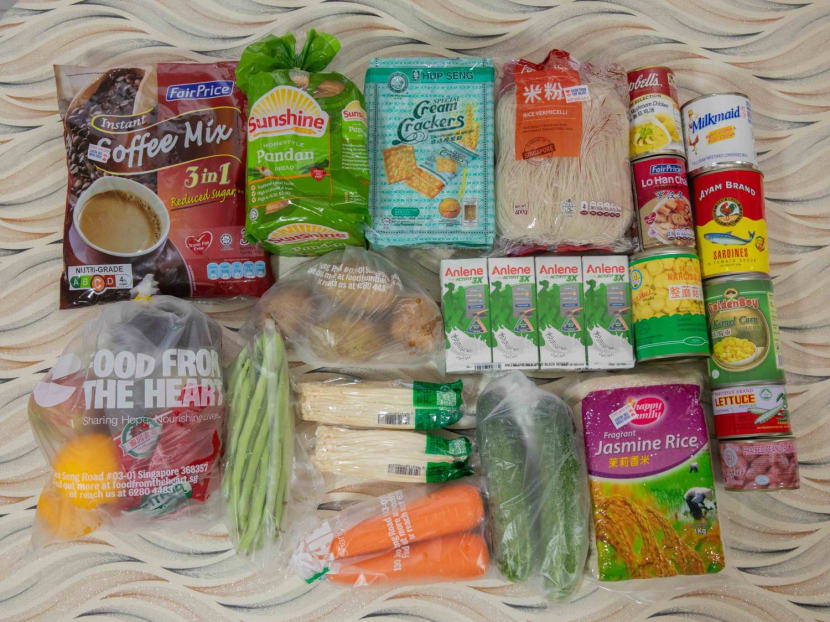
HOW GOVERNMENT AGENCIES HELP
Read also
Explainer: How will nutrition labels for freshly prepared drinks high in sugar and fat content work?
With families and NGOs feeling the pinch from rising food costs, what other avenues exist to help low-income communities keep up with a nutritious diet?
In a joint written reply to a parliamentary question last month, the Ministry of Health (MOH) and Ministry of Social and Family Development (MSF) said that they adopt a “multi-pronged strategy” to ensure lower-income families have access to nutritious meals.
The Health Promotion Board works with supermarket chains under the Healthier Choice Symbol programme to increase the variety of healthier house brand products, which are typically more affordable.
In response to TODAY’s queries, the FairPrice Group said that it provides S$3 “nutrient-packed” budget meals across its more than 60 supermarkets.
Around 7,000 of these meals, which include sushi rolls and roasted meat over steamed rice, are sold each month and there has been an increase in demand for them.
More than one tonne of “rescued food and vegetables” is also dispatched across 20 community fridges every month, to be distributed to lower-income families, or at least 2,100 people a month, it added.
Read also
'Siu Dai by default' movement lauded by drinks stall workers and customers, but some prefer the status quo
In 2022, the Lien Centre for Social Innovation at Singapore Management University conducted its second study on food insecurity, which piloted the provision of supermarket vouchers to food-insecure families.
These are households that lack access to enough food to maintain a healthy diet or are uncertain about whether they have this access.
Mr Steve Loh, executive director of the centre, said: “When given the freedom to make purchasing decisions with additional financial support, the food-insecure households made similar purchases compared to the typical Singaporean household when it came to food categories.”
The majority of families preferred to receive food support in supermarket vouchers rather than ready-made meals.
This provided them with the autonomy to buy food items in line with their dietary restrictions and food preferences.
“These findings suggest that the Government’s various financial assistance programmes for low-income families, such as ComCare and ComLink+, have the potential to empower individuals when making food decisions,” Mr Loh added.
Read also
Mind the hidden salt in your salad, soup and other ‘healthy’ food
Although making healthy food more affordable and providing direct aid to low-income residents can help, this is best done in tandem with public education on what constitutes a healthy diet, experts and NGOs said.
The joint ministry reply last month highlighted efforts to raise awareness of what constitutes a nutritious meal, such as through the Healthy with KidStart programme under MSF.
Asst Prof Ang from from the Saw Swee Hock School of Public Health suggested that the key is in having population-wide policies that improve the food environment for everyone, by making healthy food options accessible or even the default choice.
He pointed to positive efforts such as the elimination of artificial trans fats in food products and continued improvements in the formulation of beverages to have lower sugar content through industry collaborations and the launch of the Nutri-Grade labelling scheme.
“The next focus area is on reducing sodium intake, and similarly, this could be done through policies such as providing increased subsidies for potassium chloride salts,” Asst Prof Ang said in an interview before this week's announcement on the nutrition labels.
Although it is generally more expensive than sodium chloride salts, potassium chloride salts are said to reduce the risk of hypertension due to its lower levels of sodium.
GROUND-UP EFFORTS
On the ground, residents from rental estates are playing a part in improving their community's access to nutritious food and promoting healthy eating habits.Ms Normah is one beneficiary-turned-volunteer of Project Goodwill Aid. She is now responsible for distributing cooked food to around 50 other residents in her estate, liaising with home-based food businesses and private donors.
In Lengkok Bahru, 46-year-old community worker Marlina Yased stocks a community fridge with frozen meats to help families stressed by food costs and runs ground-up initiative Healthy You and Me, which focuses on health challenges in their rental estate.
She also organised an instant noodle cooking competition last month to highlight how a popular and accessible food option could be creatively modified.
Residents were provided with vegetables such as carrots, healthier instant noodle options and proteins such as shrimp to whip up a more nutritious dish.
To modify it and make a healthier meal, she added that mushrooms and greens could be added to increase fibre, and the seasoning packet could be replaced by herbs.
“I wanted to remove the stereotype of instant noodles being unhealthy. We often prepare quick and cheap meals to fill us up. Instant noodles are a staple food for all of us regardless of (whether we live in) a rental or purchased residence,” Ms Marlina said.
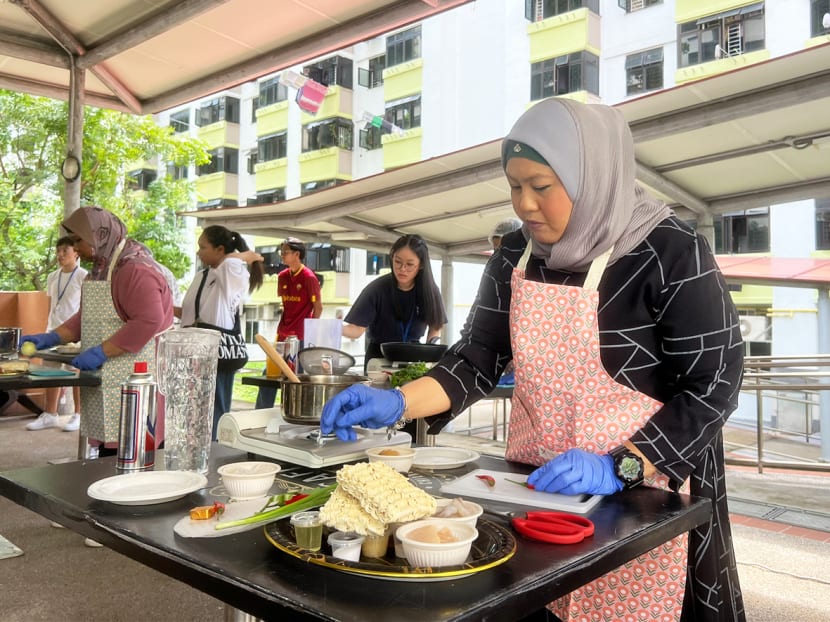
Related topics
low income families Health HPB nutritionRead more of the latest in
FeaturesExplore now
YOU MIGHT LIKETRENDING

Taiwanese actress, 72, reveals she was a mistress for 17 years, and 'it was the best time of [her] life'
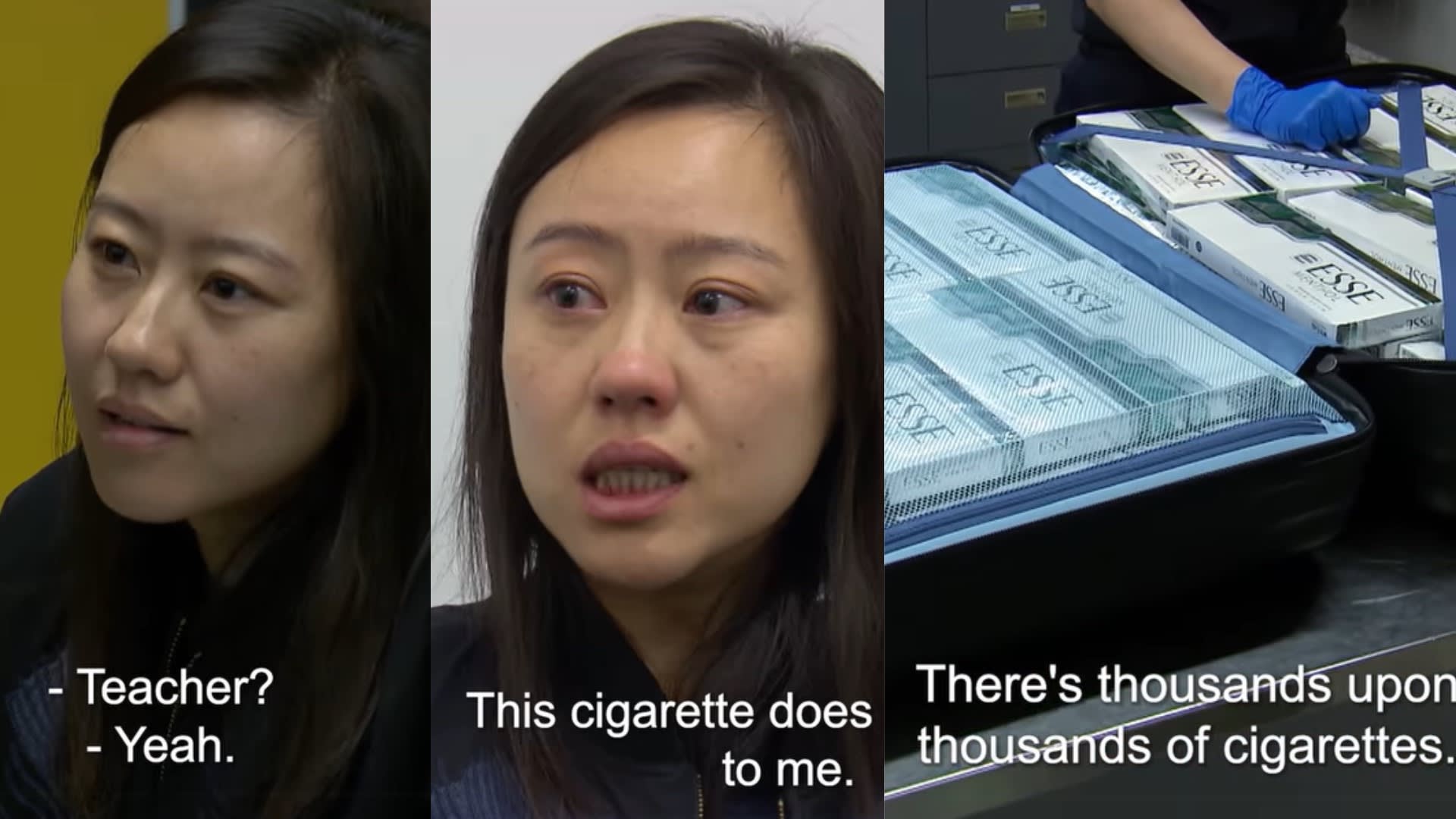
Clip of ‘S’porean teacher’ smuggling 2 suitcases of cigarettes at Melbourne Airport trends 3 years after it airs

Maggie Cheung asks Chinese fan if she's Singaporean because she spoke good English

Taiwanese actress Ady An called heartless for not visiting tycoon husband in prison
Stay in the know. Anytime. Anywhere.

Subscribe to our newsletter for the top features, insights and must reads delivered straight to your inbox.
By clicking subscribe, I agree for my personal data to be used to send me TODAY newsletters, promotional offers and for research and analysis.


- News
- Features
- Big Read
- Adulting 101
- Gen Y Speaks
- Gen Z Speaks
- Voices
- Commentary
- 8 Days
- Health
- Watch
- Brand Spotlight
- About TODAY
- Journalists
- Advertise With Us
- About Mediacorp
- Contact Us
- Mediacorp Digital Network
- Privacy Policy
- Mediacorp Terms and Conditions of Use
CONNECT WITH US
DOWNLOAD OUR APP
Copyright 2024 © Mediacorp Pte Ltd. All rights reserved.Official Domain | Terms & Conditions | Privacy Policy







